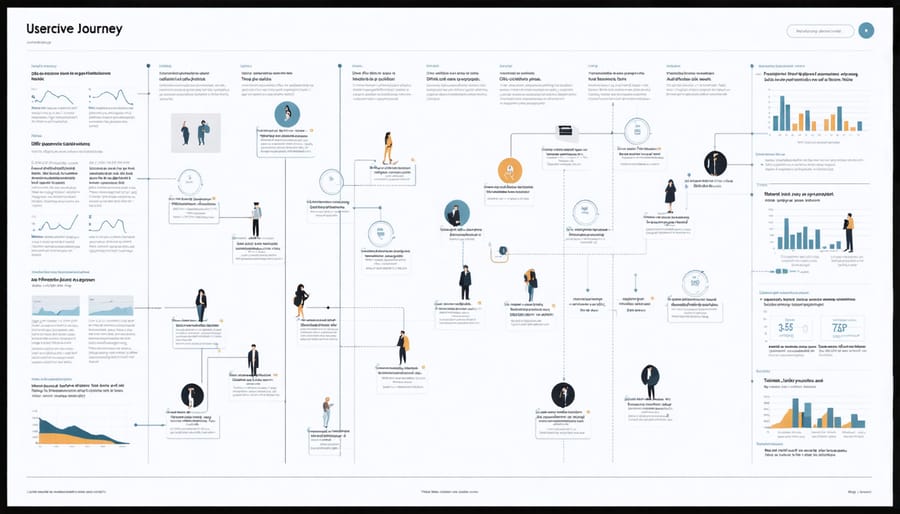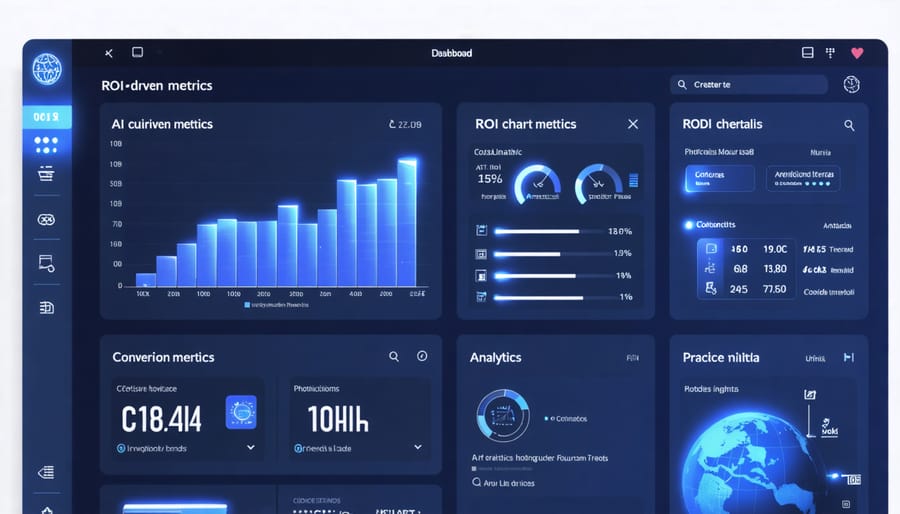Artificial intelligence is revolutionizing how businesses understand and act on their data, transforming raw information into strategic gold. By combining machine learning algorithms with traditional analytics, organizations are now uncovering patterns and insights that were previously invisible to human analysts. This AI-driven approach isn’t just accelerating decision-making—it’s fundamentally changing how we interpret customer behavior, optimize operations, and predict market trends.
Recent advances in natural language processing and deep learning have made AI analytics accessible to companies of all sizes. Instead of requiring teams of data scientists, modern AI platforms automatically clean data, identify correlations, and generate actionable recommendations in real-time. From predictive maintenance in manufacturing to personalized customer experiences in retail, AI-driven analytics is delivering ROI across industries.
The real power lies in AI’s ability to continuously learn and adapt. Unlike traditional analytics tools that rely on static models, AI systems evolve with each new data point, becoming increasingly accurate and sophisticated over time. This dynamic capability, combined with automated insight generation, is helping organizations move from reactive to proactive decision-making—turning data analytics from a retrospective tool into a strategic compass for future success.
The Power of AI in Understanding User Behaviors

Real-time Pattern Recognition
Modern AI systems excel at detecting and analyzing user behavior patterns in real-time, revolutionizing how businesses understand and respond to their customers. Through AI-powered user behavior analysis, organizations can instantly identify emerging trends, unusual activities, and shifting customer preferences as they happen.
Think of it as having thousands of attentive observers watching your digital platforms simultaneously, each picking up on subtle patterns that might escape human notice. For example, an e-commerce platform can immediately detect when multiple users start showing interest in a particular product category, allowing for instant inventory adjustments and personalized recommendations.
These real-time insights enable businesses to make split-second decisions. When a surge of users encounters difficulty with a specific feature, the system can automatically flag this pattern and trigger appropriate responses. Similarly, when customers demonstrate new shopping behaviors or engagement patterns, the AI can swiftly adapt the user experience to better serve these emerging needs.
This immediate pattern recognition capability transforms raw data streams into actionable intelligence, helping businesses stay ahead of trends rather than merely reacting to them.
Predictive Analytics Integration
Predictive analytics takes AI-driven analytics to the next level by anticipating user behaviors and needs before they occur. By analyzing patterns in historical data, AI algorithms can forecast future user actions with remarkable accuracy. These predictions encompass everything from basic user navigation patterns to complex emotional response tracking and decision-making processes.
The system works by identifying correlations between various data points, such as browsing history, click patterns, time spent on pages, and previous interactions. Machine learning models then process this information to create predictive models that continuously improve their accuracy over time. For example, an e-commerce platform might predict when a customer is likely to make their next purchase, what items they’re most interested in, or when they might need customer support.
These insights enable businesses to proactively address user needs, personalize experiences in real-time, and optimize resource allocation. Companies can pre-load content, adjust inventory levels, or deploy customer service representatives before issues arise, creating seamless user experiences that feel almost magical in their anticipation of user needs.
Building Dynamic Journey Maps with AI

Automated Touchpoint Analysis
In the modern digital landscape, AI has revolutionized how businesses understand and analyze customer touchpoints. These sophisticated systems can automatically identify and examine crucial moments when customers interact with a brand across multiple channels, providing insights that would be impossible to gather manually.
AI-powered touchpoint analysis works by collecting data from various sources like website visits, social media interactions, customer service calls, and in-app behaviors. Machine learning algorithms then process this information to recognize patterns and significant interaction points that impact customer experience. For example, an e-commerce platform might discover that customers who interact with size guides during their first visit are 40% more likely to complete a purchase.
The system continuously monitors these touchpoints in real-time, evaluating factors such as timing, context, and customer response. It can detect when customers encounter friction points, such as abandoned shopping carts or repeated support queries, and flag these for immediate attention. This proactive approach allows businesses to address issues before they escalate into larger problems.
What makes AI-driven touchpoint analysis particularly powerful is its ability to learn and adapt. As it processes more data, it becomes increasingly accurate at predicting which touchpoints are most critical for different customer segments. For instance, it might identify that millennial customers prefer chat support during evening hours, while business professionals engage more with email communications during workday mornings.
The technology also excels at connecting seemingly unrelated touchpoints to reveal hidden customer journey patterns. This comprehensive view helps organizations optimize their interaction strategies and create more personalized experiences that resonate with their target audience.
Personalization at Scale
In today’s data-driven marketplace, creating personalized digital experiences has become essential for business success. AI-driven analytics makes this possible by processing vast amounts of user data in real-time, enabling companies to deliver tailored content and recommendations to each individual user.
Think of it as having a personal shopping assistant who remembers every interaction, preference, and purchase you’ve made, but at a scale that can serve millions of customers simultaneously. AI algorithms analyze user behavior patterns, including browsing history, purchase decisions, and engagement metrics, to create detailed user profiles that evolve with each interaction.
This dynamic personalization manifests in various ways: Netflix suggests shows based on viewing habits, Amazon recommends products that complement previous purchases, and Spotify creates weekly playlists tailored to individual music tastes. These recommendations become more accurate over time as the AI systems learn from user responses and feedback.
The real power of AI-driven personalization lies in its ability to predict future behavior. By analyzing historical data patterns, AI can anticipate user needs before they arise. For example, an e-commerce platform might notice that customers who buy running shoes often purchase replacement pairs within six months, triggering personalized reminders and relevant offers at the optimal time.
For businesses, this means higher engagement rates, increased customer satisfaction, and improved conversion rates. For users, it translates to more relevant content, better product recommendations, and a smoother, more intuitive digital experience that feels uniquely their own.
Making Data-Driven Decisions
Converting Insights to Action
Transforming AI-driven insights into actionable steps requires a systematic approach that combines strategic thinking with practical implementation. Start by prioritizing the insights based on their potential impact and feasibility. Focus on quick wins that can demonstrate value while building momentum for larger initiatives.
Create a clear implementation roadmap that outlines specific actions, timelines, and responsible team members. This should include both technical requirements and business objectives. When implementing AI-driven personalization strategies, ensure that your team has the necessary skills and resources to execute effectively.
Begin with small-scale pilot projects to test your approach and gather feedback. This allows you to refine your implementation strategy while minimizing risks. Monitor key performance indicators (KPIs) throughout the process to measure success and identify areas for improvement.
Establish feedback loops between your AI systems and business outcomes. This helps in continuous optimization and ensures that your analytics solution remains aligned with evolving business needs. Regular reviews and adjustments are essential for maintaining effectiveness.
Remember to document your processes and learnings thoroughly. This creates a valuable knowledge base for future initiatives and helps in scaling successful implementations across different areas of your organization. Finally, maintain open communication channels with stakeholders to ensure continued support and alignment with organizational goals.
Measuring Impact and ROI
Measuring the impact of AI-driven analytics is crucial for justifying investments and optimizing performance. Organizations typically track both quantitative and qualitative metrics to evaluate success. Key performance indicators (KPIs) often include improved accuracy rates, reduction in processing time, and cost savings compared to traditional analytics methods.
To effectively measure ROI, start by establishing clear baseline metrics before implementing AI solutions. Track metrics such as time saved on data analysis, reduction in error rates, and improvements in decision-making accuracy. For example, a retail company might measure the accuracy of their AI-powered demand forecasting by comparing predicted vs. actual sales figures.
Modern analytics platforms offer built-in reporting tools that help monitor these metrics in real-time. Look for features like customizable dashboards, automated reporting, and A/B testing capabilities. Common tools include:
– Performance monitoring dashboards
– ROI calculators
– Impact assessment frameworks
– Data quality metrics
– User adoption rates
Remember to consider both direct financial returns and indirect benefits such as improved customer satisfaction and employee productivity. Regular assessment intervals (monthly or quarterly) help track progress and identify areas for optimization.
A comprehensive measurement framework should also include feedback loops from end-users and stakeholders. This qualitative data provides valuable insights into the practical impact of AI-driven analytics on daily operations and decision-making processes.

Future-Proofing Your Journey Maps
As AI technology continues to evolve at a rapid pace, ensuring your journey maps remain relevant and adaptable is crucial for long-term success. To future-proof your journey mapping efforts, consider implementing flexible frameworks that can easily incorporate new AI capabilities as they emerge.
Start by building a scalable data infrastructure that can handle increasing volumes and varieties of customer interaction data. This might include creating standardized data collection protocols and establishing clear documentation practices that make it easier to integrate new data sources as they become available.
Machine learning models are becoming increasingly sophisticated, and preparing for these advancements means designing your journey maps with modularity in mind. Consider creating separate layers for different types of analytics – from basic descriptive statistics to advanced predictive modeling. This layered approach allows you to upgrade specific components without overhauling your entire mapping system.
Real-time analytics capabilities are expected to become even more powerful, so ensure your journey mapping framework can accommodate instant updates and dynamic visualization. Consider implementing automated feedback loops that can continuously update your maps based on new customer behavior patterns and emerging trends.
Privacy and ethical considerations will continue to grow in importance. Future-proof your journey maps by building in robust data governance frameworks and ensuring transparency in how AI makes decisions. This includes maintaining clear audit trails and implementing explainable AI features that help stakeholders understand the reasoning behind AI-driven insights.
Keep an eye on emerging technologies like natural language processing and computer vision, as these may offer new ways to capture and analyze customer interactions. Consider how these technologies might enhance your journey maps and leave room in your implementation strategy to incorporate them.
Integration capabilities will be crucial as new tools and platforms emerge. Design your journey mapping system with open APIs and standardized data formats that can easily connect with new technologies and third-party solutions.
Finally, invest in training and development programs that keep your team updated on the latest AI analytics developments. Creating a culture of continuous learning ensures your organization can quickly adapt to and leverage new capabilities as they become available.
Remember that future-proofing isn’t about predicting every possible development, but rather about building flexible systems that can evolve alongside technological advancements. Regular reviews and updates of your journey mapping strategy will help ensure you’re always ready to embrace new opportunities in AI-driven analytics.
AI-driven analytics represents a transformative approach to journey mapping, offering organizations unprecedented insights into customer behavior and experiences. As we’ve explored throughout this article, the integration of AI technologies can significantly enhance the accuracy, efficiency, and depth of journey mapping analyses.
The key takeaways for successful implementation include starting with clear objectives, ensuring data quality and accessibility, and adopting a phased approach to integration. Organizations should begin by identifying specific pain points in their current journey mapping process that AI can address, whether it’s pattern recognition, predictive analytics, or real-time personalization.
To get started, consider these practical next steps:
1. Audit your existing data collection methods and quality
2. Identify key metrics and KPIs that align with your business goals
3. Start small with pilot programs in specific customer segments
4. Invest in staff training and change management
5. Regularly evaluate and adjust your implementation strategy
Remember that AI-driven analytics is not a one-time implementation but an evolving process. Stay current with emerging technologies and best practices, and maintain a customer-centric focus throughout your journey mapping initiatives.
The future of journey mapping lies in the intelligent combination of human insight and AI capabilities. By embracing this technology while maintaining a strategic approach, organizations can create more meaningful, personalized, and effective customer experiences that drive business success.
Success in this endeavor requires commitment, patience, and a willingness to adapt. Start your AI journey mapping transformation today, and remember that every step forward is progress toward more sophisticated and valuable customer insights.

